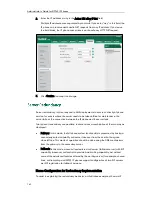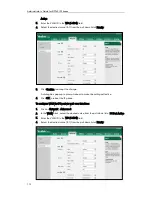
Administrator’s Guide for SIP-T4X IP Phones
174
VPN (Virtual Private Network) is a secured private network connection built on top of
public telecommunication infrastructure, such as the Internet. It provides remote offices
or individual users with secure access to their organization's network. VPN has become
more prevalent due to the benefits of scalability, reliability, convenience and security.
There are two types of VPN access: remote-access VPN (connecting an individual
device to a network) and site-to-site VPN (connecting two networks together).
Remote-access VPN allows employees to access their company's intranet from home or
outside the office, and site-to-site VPN allows employees in geographically separated
offices to share one cohesive virtual network. VPN can be also classified by the
protocols used to tunnel the traffic. It provides security through tunneling protocols:
IPSec, SSL, L2TP and PPTP.
IP phones support SSL VPN, which provides remote-access VPN capabilities through SSL.
OpenVPN is a full featured SSL VPN software solution that creates secure connections in
remote access facilities, designed to work with the
TUN/TAP
virtual networking interface.
TUN and TAP are virtual network kernel devices. TAP simulates a link layer device and
provides a virtual point-to-point connection, while TUN simulates a network layer device
and provides a virtual network segment. IP phones use OpenVPN to achieve the VPN
feature. To prevent disclosure of private information, tunnel endpoints must authenticate
each other before secure VPN tunnel is established. After the VPN feature is configured
properly on the IP phone, the IP phone acts as a VPN client and uses the certificates to
authenticate the VPN server.
To use the VPN feature, the compressed package of VPN-related files should be
uploaded to the IP phone in advance. The file format of the compressed package must
be .tar. The VPN-related files are: certificates (ca.crt and client.crt), key (client.key) and
the configuration file (vpn.cnf) of the VPN client. For more information on how to
package a .tar file, refer to
OpenVPN Feature on Yealink IP Phones
.
Procedure
VPN can be configured using the configuration files or locally.
Configuration File
<y0000000000xx>.cfg
Configure the OpenVPN feature
and upload a tar file to the IP
phone.
For more information, refer to
VPN
on page
347
.
Local
Web User Interface
Configure the OpenVPN feature
and upload a tar package to
the IP phone.
Navigate to:
http://<phoneIPAddress>/servl
Summary of Contents for SIP-T4X
Page 1: ...T 4 XI PP h o n e A d mi n i s t r a t o r G u i d e...
Page 2: ......
Page 15: ...Administrator s Guide for SIP T4X IP Phones xiv...
Page 23: ...Administrator s Guide for SIP T4X IP Phones 8...
Page 217: ...Administrator s Guide for SIP T4X IP Phones 202...
Page 233: ...Administrator s Guide for SIP T4X IP Phones 218...
Page 245: ...Administrator s Guide for SIP T4X IP Phones 230...
Page 257: ...Administrator s Guide for SIP T4X IP Phones 242...
















































